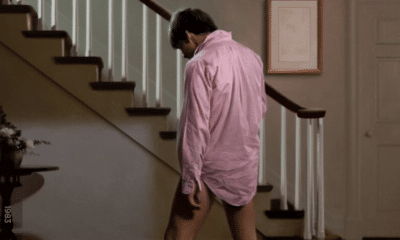Based upon his 2017 short, Larry, Come Play marks Jacob Chase’s first venture into feature film territory. The original short told of a car parking attendant who got into trouble after finding an abandoned tablet in the lost and found. The feature film continues the journey of that tablet as it ends up in the hands of a young autistic boy, Oliver (Azhy Robertson). Unable to speak, Oliver uses electronic devices to communicate. After bullies get rid of his phone, he is thrilled to be presented with a tablet by his father (played by John Gallagher Jr.). His happiness soon turns to dread however, as he encounters a chilling storybook app featuring a monster called Larry. Larry seems to have a fascination with Oliver and before long Oliver and his mother Sarah (Gillian Jacobs) find themselves in a battle for their lives.

Come Play follows a similar pattern to other shorts extended out to feature, building well on the foundations. It most closely follows the formula of Light’s Out, and whilst Come Play makes for an entertaining watch, it does have the occasional whiff of conveyor belt horror. There’s also not quite enough material to keep the story moving forward in a way that fully captivates the audience’s attention. The strengths lie in the themes explored, motherhood being the key one. It’s not the first time that motherhood has been cast into the horror spotlight and Come Play shares a lot with Jennifer Kent’s The Babadook. Gillian Jacobs giving a great turn as a desperate mother on the edge.
Where Come Play shines is in its handling of Oliver’s autism. Films often portray autism in the same way whereas everybody knows that people with the condition all behave differently. Oliver isn’t the stereotype that we’ve had forced down our throats. Robertson does a brilliant job with his portrayal, but his work has been heavily helped by Chase’s writing. Chase’s wife works with autistic kids for a living and there’s an authenticity to the research that is missing from many other movies. The design of Larry is another highlight. Interestingly, the character is a puppet, one brought to life by four puppeteers. Recent years have seen an over reliance on CGI to create the creep factor, but as Come Play proves, you can’t beat practical effects.
There are some great elements on display in Come Play, but it sadly runs out of steam by the time the finale comes around. The climax itself steers the film into dark and haunting territory effectively, it just comes after too much of a lull. Potentially a short that should have stayed in its short format, Come Play never quite outwears its welcome, but does have some pacing issues.
Come Play
Kat Hughes
Summary
The Babadook meets Light’s Out, overall Come Play feels a little cookie cutter horror, but still manages to get a couple of good scares in.
Come Play is available on Digital HD now.
Kat Hughes is a UK born film critic and interviewer who has a passion for horror films. An editor for THN, Kat is also a Rotten Tomatoes Approved Critic. She has bylines with Ghouls Magazine, Arrow Video, Film Stories, Certified Forgotten and FILMHOUNDS and has had essays published in home entertainment releases by Vinegar Syndrome and Second Sight. When not writing about horror, Kat hosts micro podcast Movies with Mummy along with her five-year-old daughter.

Latest Posts
-


Home Entertainment
/ 3 hours ago‘Risky Business’ and ‘Blow Out’ are getting the UK Criterion treatment
Risky Business and Blow Out will be released on UK Criterion 4K Blu-ray this...
By Paul Heath -


Film News
/ 3 hours agoRelease date announced for ‘The Outrun’ with Saoirse Ronan
After premiering at this year’s Sundance and the Berlinale in Germany, the UK release...
By Paul Heath -


Apple TV
/ 1 day agoTrailer: André Holland leads Apple’s new limited series, ‘The Big Cigar’
Apple TV+ has released the full trailer for The Big Cigar, a new, six-episode...
By Paul Heath -


Film News
/ 1 day agoUK trailer, poster and release date for Sundance smash ‘Sasquatch Sunset’
Premiering in the UK at the Sundance London event in June is the brilliant...
By Paul Heath













